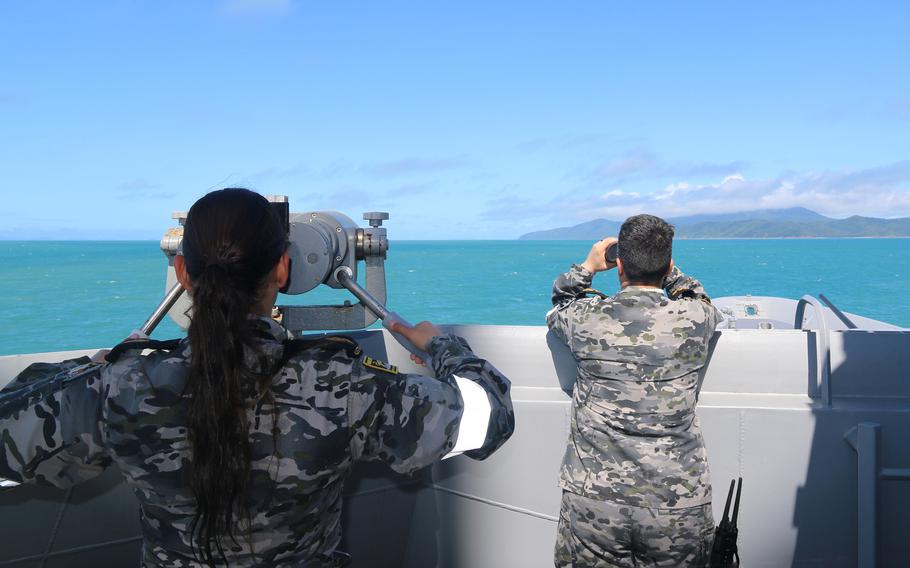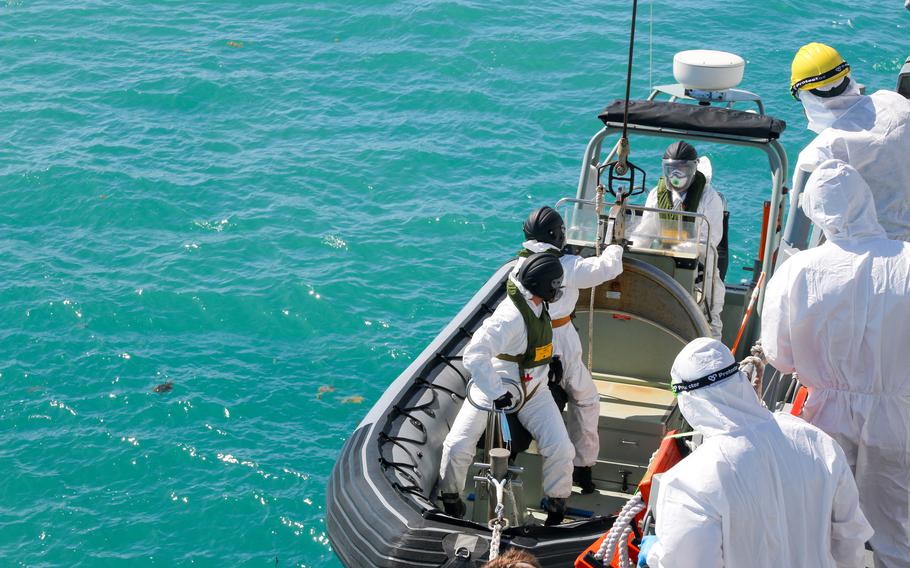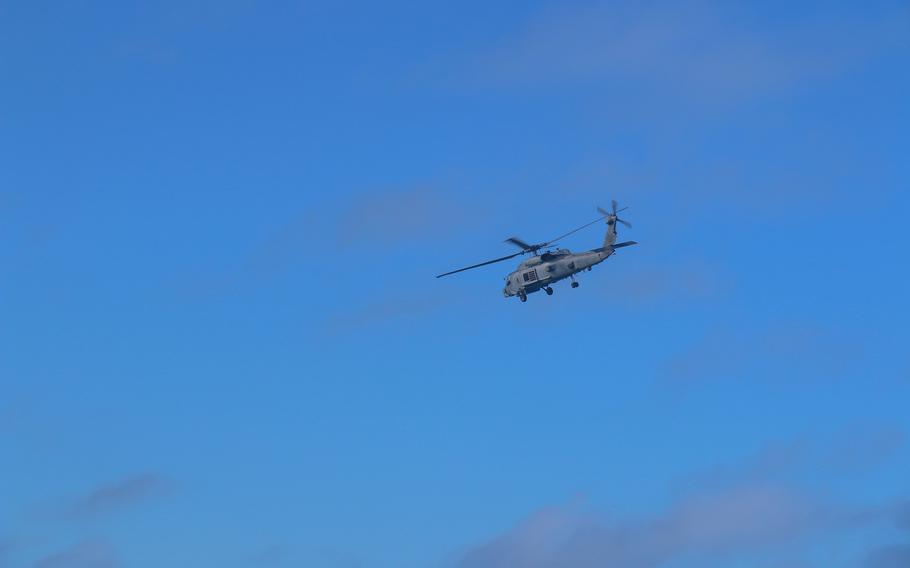
Australian navy sailors aboard the guided-missile destroyer HMAS Brisbane scan the horizon during search-and-rescue efforts near Lindman Island in Queensland, Australia, Saturday, July 29, 2023. (Australian Defence Force)
ROCKHAMPTON, Australia — Search-and-rescue efforts continue for four aviators missing since their Australian army helicopter crashed late Friday during the multinational Talisman Sabre exercise.
Capt. Danniel Lyon, Lt. Maxwell Nugent, Warrant Officer Class 2 Joseph Laycock and Cpl. Alexander Naggs were aboard an MRH-90 Taipan that ditched in waters near Hamilton Island around 10:30 p.m., said Australian army Lt. Gen. Simon Stuart.
All are members of the army’s 6th Aviation Regiment, he announced during a televised press conference on Sunday at Holsworthy Barracks in Sydney.
“There is now a major international effort engaged in the search-and-rescue of the crew, which is involving hundreds of Defence Force personnel,” Australian Defense Minister Richard Marles said at a separate press conference that afternoon in Townsville.

Australian navy sailors from the guided-missile destroyer HMAS Brisbane board an inflatable vessel during search-and-rescue efforts near Lindeman Island in Queensland, Australia, Saturday, July 29, 2023. (Australian Defence Force)
Talisman Sabre activities, which were paused immediately after the crash, resumed late Saturday afternoon on a limited basis.
While some wreckage from the aircraft has been found, the main part of the airframe is still missing, Marles said.
“There are specialist assets which are on task right now which are doing that job,” he said. “Our thoughts are with the aircrew. Our thoughts are with their families and with their teammates who we've met today, and who will be experiencing an enormous degree of anxiety in this moment.”
Ships involved in search-and-rescue efforts, underway since late Friday, include two Australian navy vessels — the landing helicopter dock ship HMAS Adelaide and the guided-missile destroyer HMAS Brisbane — and a U.S. Navy expeditionary mobile base, the USS Miguel Keith, according to Lt. Gen. Greg Bilton, the Australian Defence Force’s chief of joint operations.
“There are also specialist divers who commenced operations this morning almost immediately after arrival and we seek to continue to find the full fuselage of that aircraft,” he said at the press conference Sunday in Townsville.
U.S. and Australian warships, including the Miguel Keith and the minehunter HMAS Huon, paused their Talisman Sabre training near the Queensland port of Gladstone to join the search, Australian navy Cmdr. Paul Doble told Stars and Stripes during an interview at an army depot near the port on Sunday.
Doble, who serves as the littoral combat planner for the exercise, said the vessels are equipped with autonomous and remote operated undersea vehicles.
Bilton acknowledged the support from allies and partners, particularly the United States.
“Once again, the same resolute support that we're receiving now as we've received in the past,” he said. “And we're grateful for it.”

An MH-60R helicopter from the guided-missile destroyer HMAS Brisbane joins search-and-rescue efforts near Lindeman Island in Queensland, Australia, Saturday, July 29, 2023. (Australian Defence Force)
U.S. Defense Secretary Lloyd Austin, who traveled to Townsville on Sunday, held a press conference with Secretary of State Antony Blinken on Saturday afternoon alongside their Australian counterparts, Marles and Foreign Minister Penny Wong.
“Our thoughts and prayers are with the [Australian Defence Force] and the four Australian service members who were involved in the helicopter crash while supporting exercise Talisman Sabre,” Austin said. “I told the [Prime Minister Anthony Albanese] whatever he needs we stand ready to provide assistance.”
The missing Australian aircrew were performing their duties alongside American servicemen and women, Blinken added.
“They remain very much on our minds right now,” he said.
Australia’s Taipan fleet has been plagued with difficulties, broadcaster ABC reported Saturday.
Ten troops were rescued from waters off New South Wales in March after their Taipan ditched into the sea during counterterrorism training, the report said. The fleet was also grounded in 2019 to fix tail rotors.
During the Talisman Sabre exercise in 2017, three U.S. Marines were killed when an MV-22 Osprey crashed off Queensland’s coast.
Investigators, in a report issued the following spring, said the accident was caused by a heavy downwash of air as the aircraft, assigned to Marine Medium Tiltrotor Squadron 265 on Okinawa, attempted to land aboard the USS Green Bay.
This year’s Talisman Sabre, featuring 30,000 troops from 13 countries, kicked off July 21 and swung into gear with two live-fire drills the following day at sites 1,000 miles apart. Hosted by Australia along its eastern coast, the exercise is scheduled to conclude Aug. 4.